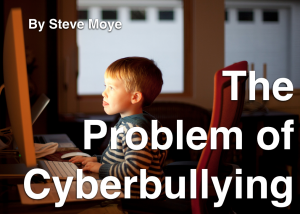 As fun as the Internet and social media can be, it’s led to one disturbing trend, particularly among teens: cyberbullying. In a nine-school survey by the Cyberbullying Research Center, about 26.3 percent of middle- and high-school students indicated that they’d been bullied. This was up from about 18.8 percent back in 2007, and last year climbed to around 34 percent. According to the American Academy of Pediatrics, bullying and pathological Internet use are prime risk factors for teen suicide. So something that combines the two of those, namely cyberbullying, is particularly worrisome. They reported that Internet use in excess of five hours a day has been linked to depression and suicide. Children between the ages of 8 and 12 spend on average six hours a day in front of screens, a number that jumps to nine for teens.
As fun as the Internet and social media can be, it’s led to one disturbing trend, particularly among teens: cyberbullying. In a nine-school survey by the Cyberbullying Research Center, about 26.3 percent of middle- and high-school students indicated that they’d been bullied. This was up from about 18.8 percent back in 2007, and last year climbed to around 34 percent. According to the American Academy of Pediatrics, bullying and pathological Internet use are prime risk factors for teen suicide. So something that combines the two of those, namely cyberbullying, is particularly worrisome. They reported that Internet use in excess of five hours a day has been linked to depression and suicide. Children between the ages of 8 and 12 spend on average six hours a day in front of screens, a number that jumps to nine for teens.
Last year, the horror movie “Unfriended” explored the concept of what cyberbullying means to youths who more and more live online. In the film, an embarrassing video of a girl is shown on social media, and the resulting cyberbullying from her peers, many of them her friends, leads to her suicide. That’s only a small part of the movie, yet it represents a growing problem for teens. According to Walden Behavioral Care CMO James Greenblatt, it’s becoming a more and more common precipitant of the downward spiral of depression and suicide among teens.
Cyberbullying has in many ways grown into a global epidemic, harming children and families regardless of their socioeconomic background. Before the age of social media, you could avoid bullying by simply going home, yet as long as you’re near WiFi, you can’t really escape it. Victims are often targeted on social media, online forums or other websites, in addition to texting.
While digitization has decreased the degrees of separation between everybody and solved many problems in the process, it has worsened bullying. If there were an easy solution, the bullying problem would be declining, yet everybody from parents to policy makers need to rely on various mitigation tools. One way to combat bullying is to let teens know about the damage it does, yet that doesn’t always help. It’s also critical to offer guidance to those hurt by cyberbullying. Luckily, our digital footprints make bullying more and more visible, with hateful remarks showing up on public forums and social accounts at an alarming rate.
While various social media sites are trying out new tools to stop online abuse, certain tools, such as STOPit, are taking matters into their own hands. This app removed the friction from the reporting process of cyberbullying, allowing victims and others to snap shots and capture videos to send to school officials. Within just a few months of launching STOPit, schools have said that they’ve seen a decrease in all types of issues, proving it an effective deterrent. Yet while this app has helped, in the end it’s going to be cultural shifts that cause the most change. And with the increasing use of digital media, it’s unclear when that will happen.
If you’d like to learn more, you can click here!
